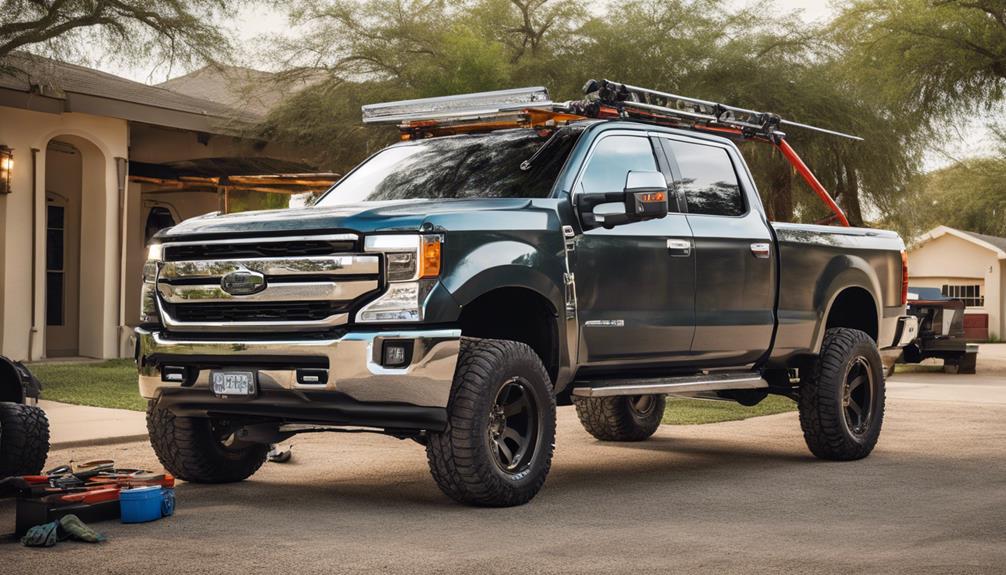For an effortless lift kit installation in Brownsville, TX, adhere to expert tips. Choose a lift kit based on your off-road goals and vehicle specs. Confirm compatibility and prioritize handling and stability. Organize tools meticulously, prioritize safety gear, and focus on efficiency. Prepare your vehicle on a level surface with proper ventilation. Follow a step-by-step process, referring diligently to instructions. Double-check connections, align post-installation, and test drive. After installation, conduct regular maintenance, alignment checks, and part inspections. Drive responsibly for a safe experience. Master these steps for a successful lift kit installation in Brownsville, TX.
Key Takeaways
- Choose a lift kit compatible with your vehicle's make and model.
- Ensure all necessary tools are prepared and in good condition.
- Follow step-by-step instructions meticulously for a seamless installation.
- Verify alignment post-installation to maintain handling and stability.
- Consider professional installation services for a hassle-free experience.
Lift Kit Selection Tips
When selecting a lift kit for your vehicle, it is crucial to understand your off-road goals and your vehicle's specifications to guarantee smooth integration and peak performance. To optimize off-road performance, consider your vehicle's weight, wheelbase, and suspension system when choosing a lift kit. Body lifts are primarily for aesthetics, while suspension lifts enhance off-road capabilities by increasing ground clearance and articulation. Make sure the lift kit is compatible with your vehicle's make and model to prevent fitment issues. A well-suited lift kit will not only improve off-road performance but also maintain your vehicle's handling and stability. By tailoring the lift kit based on your vehicle specifications, you can achieve the perfect balance between style and functionality.
Essential Tools Checklist
Prepare the essential tools necessary for a successful lift kit installation by creating a detailed checklist and making sure all equipment is in peak condition. When organizing your tools, keep efficiency in mind to streamline the installation process. Prioritize safety by inspecting tools for wear and tear to prevent any hazards during the installation. Remember to wear proper personal protective equipment and maintain a clean workspace for best conditions. Here are three key items to include in your essential tools checklist:
- Wrenches and Sockets: Confirm you have the correct sizes for your vehicle's specific requirements.
- Torque Wrench: Essential for tightening bolts to the manufacturer's specifications.
- Lift Equipment: Ensure all lift components are in good working order to safely elevate your vehicle.
Vehicle Preparation Guidelines

Organize a level surface and guarantee proper ventilation when parking your vehicle for lift kit installation, maintaining alignment to safeguard against uneven tire wear. Before beginning, check your vehicle's warranty for potential implications of the lift kit installation. Proper alignment is essential to prevent uneven tire wear, ensuring peak performance post-installation. Keeping your vehicle's alignment in check will not only enhance safety but also prolong the lifespan of your tires. Be mindful of the warranty implications associated with modifications, as some changes may affect coverage. By adhering to alignment checks and warranty considerations, you set the stage for a successful lift kit installation, maximizing both performance and peace of mind.
Step-by-Step Installation Process
Begin by carefully disassembling the necessary parts to avoid any damage during the installation process. Follow these steps for a smooth lift kit installation:
- Installation Tips:
- Refer to the lift kit instructions meticulously for precise guidance.
- Double-check all connections and fastenings to guarantee security.
- Conduct a test fit before finalizing the installation to troubleshoot any potential issues.
- Safety Precautions:
- Use appropriate personal protective equipment to prevent injuries.
- Lift the vehicle safely using recommended equipment and techniques.
- Have a spotter available to assist during critical installation steps.
- Alignment Adjustments:
- Verify vehicle alignment post-installation to prevent tire wear.
- Make necessary adjustments to align suspension components properly.
- Test drive the vehicle to confirm alignment and address any issues promptly.
Post-Installation Care and Maintenance

After completing the lift kit installation, make sure you prioritize regular inspections and maintenance to uphold your vehicle's performance and safety standards effectively. Start by conducting alignment checks to prevent uneven tire wear and ensure peak handling. Regularly inspect suspension components for any signs of wear or damage, and perform necessary maintenance to keep them in top condition. Drive responsibly to avoid premature suspension wear caused by aggressive off-roading or overloading. Understand the warranty implications of modifications on your vehicle's warranty to avoid any surprises. By maintaining your vehicle's performance and safety through regular inspections and responsible driving, you can prolong the benefits of your lift kit installation and enjoy a lifted life responsibly.
Frequently Asked Questions
Can I Install a Lift Kit on My Vehicle if It's Leased?
You're cruising on a leased vehicle, eyeing that lift kit for a rugged transformation. Yet, lease restrictions loom. Navigate the installation challenges meticulously. Check lease terms for consent, possible penalties. Proceed cautiously to avoid lease complications.
Is It Necessary to Upgrade My Tires With a Lift Kit?
When upgrading your vehicle with a lift kit, tire compatibility is essential. Suspension modifications can necessitate larger tires for best performance. Confirm proper alignment and consider tire size to prevent issues post-installation, enhancing both aesthetics and functionality.
How Long Does a Typical Lift Kit Installation Take?
To install a lift kit, make sure you have a thorough understanding of installation timelines and lift kit benefits. Following precise instructions, a typical installation usually takes 6-8 hours. Enjoy the enhanced off-road capabilities and rugged appearance post-installation.
Do I Need to Recalibrate My Vehicle's Electronics After Installing a Lift Kit?
Prior to hitting the road post-lift kit installation, make sure to recalibrate your vehicle's electronics. Verify the proper functioning of suspension and alignment systems. Neglecting this step may lead to issues like incorrect readings and compromised safety.
Are There Any Specific Driving Techniques I Should Follow After a Lift Kit Installation?
After installing a lift kit, practice cautious off-road driving techniques to protect your vehicle and enhance its longevity. Adhere to recommended maintenance tips to sustain peak performance and safety on rugged terrains.